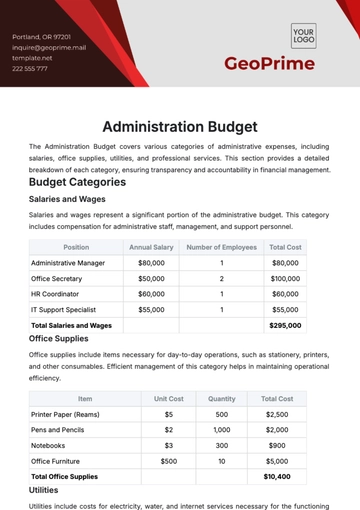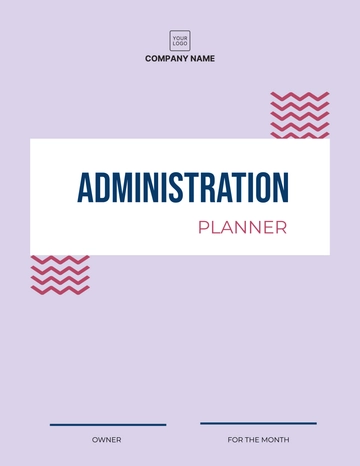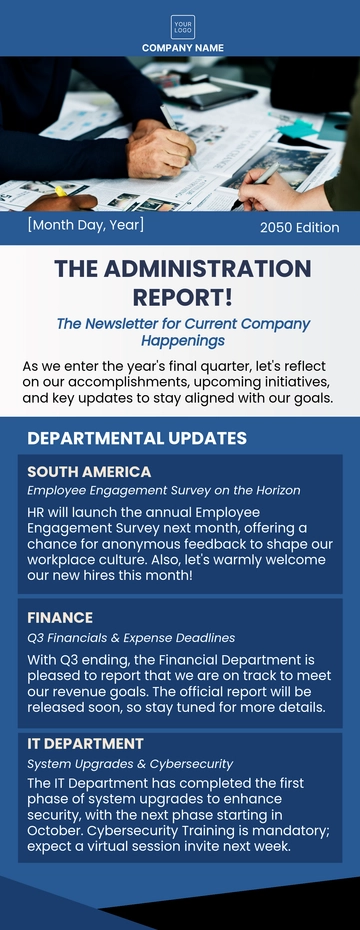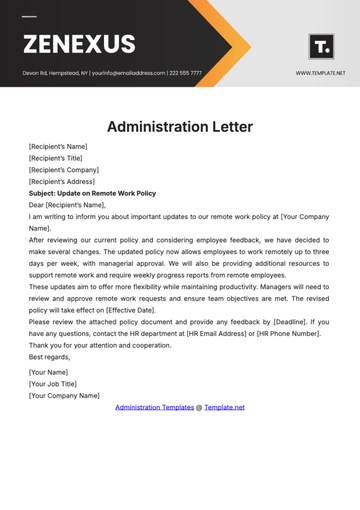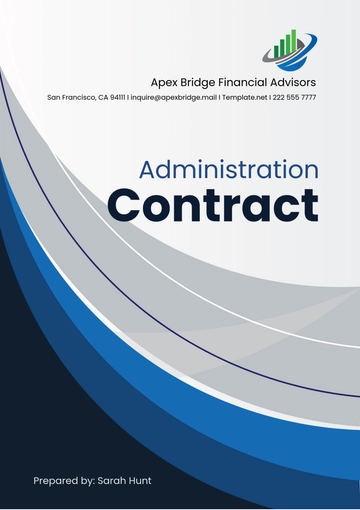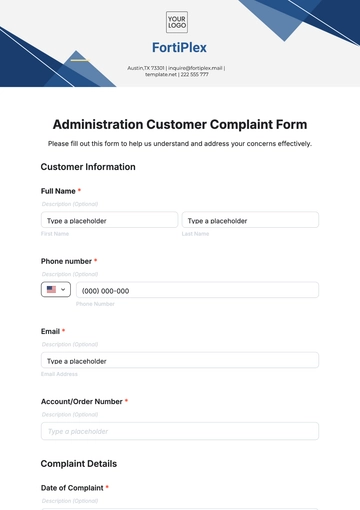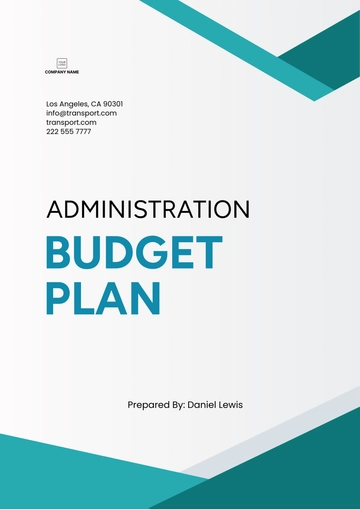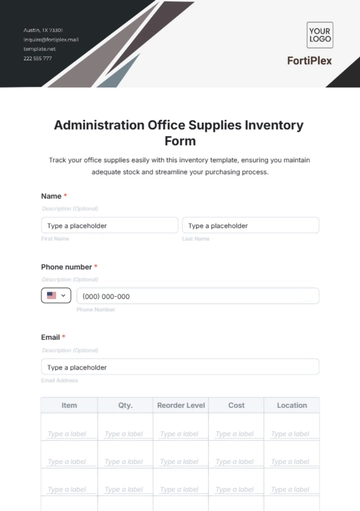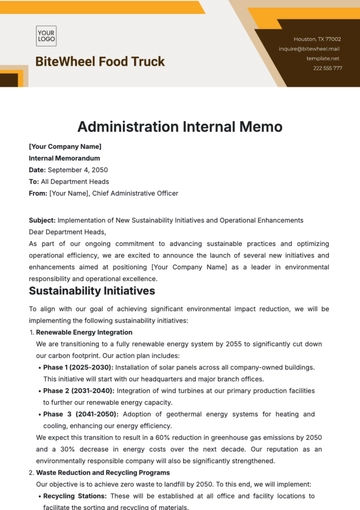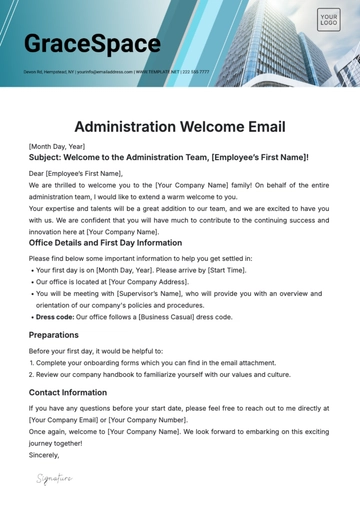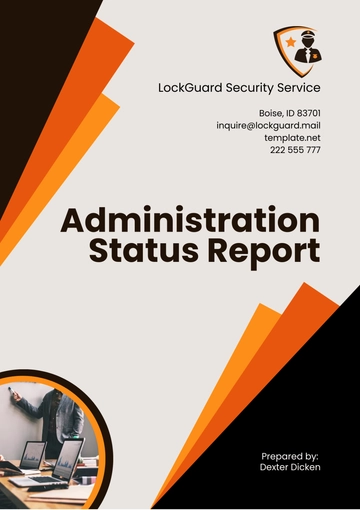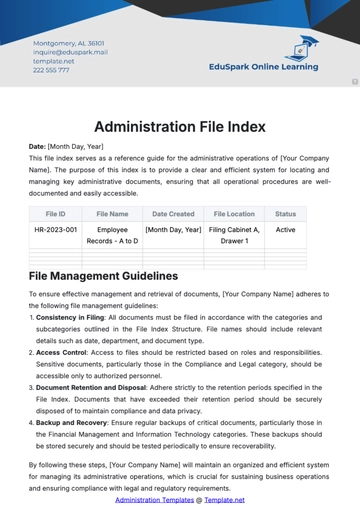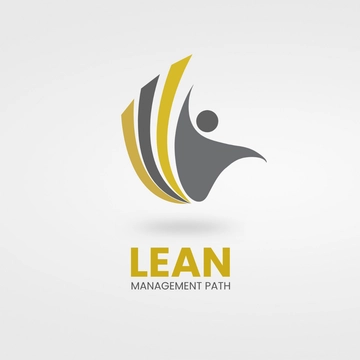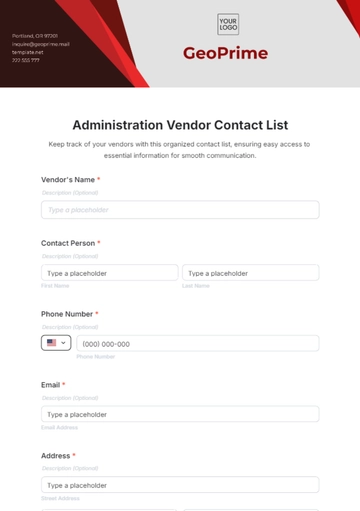Free Administration Financial Feasibility Study

Executive Summary
This feasibility study aims to evaluate the practicality and financial implications of implementing a new Administration Financial System (AFS) at [Your Company Name]. The study encompasses an analysis of the current financial management practices, the requirements for the new system, potential solutions, and a financial forecast based on the implementation of the chosen AFS.
The objective is to ascertain whether the proposed system will meet the Company's financial management needs effectively and efficiently, thereby supporting its strategic goals and operational requirements.
Current Financial Management Assessment
The thorough review of [Your Company Name]'s present financial management system has closely scrutinized its efficiency, limitations, and the essential improvements required. This detailed analysis has highlighted four key areas for enhancement:
Advanced Automation Integration: There's a critical need to incorporate more sophisticated automation processes. This will streamline financial operations, reduce manual errors, and increase efficiency across all financial transactions and processes.
Real-Time Financial Data Access: The assessment underscored the importance of deploying systems that provide instant access to financial information. This capability is crucial for making timely, informed decisions and maintaining agility in financial management.
Improved Reporting Capabilities: To gain a more nuanced understanding of financial performance, there's a demand for upgraded reporting features. These enhancements will enable the Company to generate more insightful, detailed financial reports, aiding in strategic planning and performance analysis.
Robust Compliance Management: Strengthening the protocols for compliance management has been identified as essential. This involves implementing measures that ensure strict adherence to all relevant financial regulations and standards, thus effectively mitigating risks associated with non-compliance.
Addressing these areas is vital for advancing [Your Company Name]'s financial management system to better support its strategic goals and improve overall operational efficiency.
Requirements for the New System
For [Your Company Name] to achieve a comprehensive upgrade in its financial management capabilities, the new Administration Financial System (AFS) must be designed with a robust set of features and functionalities that address current inefficiencies and future growth. The system should encapsulate the following enhanced requirements to ensure it not only meets but exceeds the Company's expectations:
Advanced Financial Planning, Budgeting, and Forecasting Tools: The AFS should offer sophisticated tools that facilitate detailed financial planning, precise budget allocation, and accurate forecasting. These tools must support dynamic scenarios and what-if analyses, enabling the Company to strategize effectively under various financial conditions and foresee the impact of different business decisions.
Real-Time Financial Reporting and Analytics: To foster a culture of data-driven decision-making, the AFS must provide capabilities for generating real-time financial reports and analytics. This includes dashboards that present key financial indicators, trend analyses, and predictive insights, allowing management to grasp the financial health of the Company at any moment and respond swiftly to changes.
Enhanced Compliance and Risk Management Features: Given the complexity of financial regulations, the new system must incorporate comprehensive compliance management tools. These should automate the tracking and reporting of compliance with all relevant laws and standards, including tax regulations and financial reporting requirements. Additionally, risk management features should identify, assess, and mitigate financial risks, safeguarding the Company against potential financial losses and regulatory penalties.
Scalability and Integration Capabilities: As [Your Company Name] continues to grow, the AFS must be scalable to accommodate increased transaction volumes, new business lines, and geographic expansion. Integration capabilities are equally critical, ensuring the AFS can seamlessly connect with other business systems to enable fluid data exchange and provide a unified view of the Company's operations.
User-Friendly Interface and Accessibility: To ensure widespread adoption and minimize training requirements, the AFS must feature an intuitive, user-friendly interface. Accessibility features should be included to accommodate users with varying degrees of ability, ensuring all team members can efficiently use the system.
Robust Security Measures: Given the sensitivity of financial data, the AFS must incorporate state-of-the-art security measures, including data encryption, multi-factor authentication, and regular security audits, to protect against unauthorized access and cyber threats.
Customization and Flexibility: Recognizing the unique aspects of [Your Company Name]'s operations, the AFS should offer customization options to tailor the system to specific business needs and workflows, ensuring it can adapt to the evolving demands of the Company.
By addressing these enhanced requirements, the new Administration Financial System will not only remedy the current system's deficiencies but also provide a scalable, secure, and efficient platform that propels [Your Company Name] towards achieving its strategic financial objectives.
Solution Analysis
To determine the most suitable Administration Financial System for [Your Company Name], a rigorous comparative analysis was conducted. This analysis meticulously evaluated various AFS solutions based on critical criteria: feature set, scalability, ease of integration, and cost. The objective was to identify a system that not only addresses the current financial management needs but also aligns with the Company’s strategic growth plans.
Comparative Analysis Table:
Criteria | Solution A | Solution B | Solution C | Solution Used |
|---|---|---|---|---|
Feature Set | Comprehensive | Moderate | Extensive | Solution C |
Detailed Evaluation:
Solution A offers a robust set of features with excellent scalability and ease of integration. It is priced moderately, making it a viable option for businesses that prioritize seamless integration and scalability but have budget constraints.
Solution B is the most cost-effective option, featuring a moderate feature set and scalability. Its integration complexity, however, may pose challenges for businesses with limited IT resources.
Solution C stands out with an extensive feature set and high scalability, designed to accommodate mid-to-large scale businesses with complex financial management needs. Despite its higher cost and moderate integration difficulty, it offers the best overall value, considering [Your Company Name]'s requirements for comprehensive features and growth potential.
After a thorough analysis, Solution C is recommended as the optimal Administration Financial System for [Your Company Name]. It provides an extensive range of features essential for advanced financial planning, reporting, and compliance management. Its scalability ensures that the system can grow with the Company, addressing both current and future needs.
While the cost is higher compared to other options, the investment is justified by the system's capabilities and the value it adds to the Company’s financial management practices. The moderate ease of integration is a manageable challenge, considering the long-term benefits and efficiencies gained.
Implementing Solution C will equip [Your Company Name] with a powerful tool to enhance financial operations, support strategic decision-making, and ensure compliance, thereby contributing significantly to the Company's growth and success.
Financial Forecast
To ensure a strategic approach towards the implementation of the recommended Administration Financial System, a detailed financial forecast has been developed. This forecast considers the initial investment required for system setup, ongoing operational expenses, and the anticipated return on investment (ROI). The ROI is projected based on efficiency improvements and cost savings that the new system is expected to deliver over time.
Financial Forecast Table:
Item | Year 1 | Year 2 | Year 3 | Cumulative |
|---|---|---|---|---|
Initial Investment Cost | $250,000 | $55,000 | $60,000 | $250,000 |
Detailed Financial Analysis:
Initial Investment Cost: The upfront cost of [$250,000] covers the purchase of the AFS, including software licenses, hardware (if necessary), and implementation services. This is a one-time expense incurred in the first year.
Operational Expenses: These are ongoing costs associated with the operation of the AFS, including maintenance, support, and periodic updates. Starting at [$50,000] in the first year, these expenses are expected to increase annually by 10% due to scaling and additional feature integration.
Efficiency Gains: This represents the monetary value of increased operational efficiency, including time savings and reduced manual effort. Starting at [$30,000] in the first year, gains are projected to increase as the system becomes more integrated into daily operations.
Cost Savings: Reflects direct cost reductions from reduced errors, lower operational risks, and decreased dependency on external financial management services. These savings are anticipated to grow as the system optimizes financial processes over time.
Net Impact and Cumulative ROI: The net impact takes into account the initial investment, operational expenses, efficiency gains, and cost savings. By the end of Year 3, the forecast projects a cumulative ROI of [$15,000], signifying a positive return from the AFS implementation.
The financial forecast underscores a strategic investment in the recommended AFS, highlighting a path to achieving a positive ROI within three years. The initial investment and operational expenses are counterbalanced by tangible efficiency gains and cost savings, demonstrating the financial viability and long-term benefits of the system. This analysis supports the decision to proceed with the AFS implementation, positioning [Your Company Name] to enhance its financial management capabilities and support its growth objectives effectively.
Implementation Plan
In order to ensure the successful deployment of the new Administration Financial System (AFS) at [Your Company Name], a detailed implementation plan will be meticulously developed. This plan will encompass a comprehensive timeline, key milestones, resource allocation, and risk management strategies to facilitate a smooth and efficient transition to the new system.
Implementation Plan Overview:
Project Timeline: A detailed timeline will be created outlining the various phases of the implementation process, including planning, system configuration, testing, training, and deployment. Each phase will be assigned specific start and end dates to ensure adherence to project deadlines.
Key Milestones: Critical milestones will be identified to mark significant achievements throughout the implementation journey. These milestones will serve as checkpoints to monitor progress and ensure that the project stays on track.
Resource Allocation: Resources, including personnel, budget, and technology infrastructure, will be allocated strategically to support the implementation process. Dedicated project teams will be assigned responsibilities and tasks, ensuring accountability and efficient utilization of resources.
Risk Management Strategies: A comprehensive risk management plan will be developed to identify potential risks and mitigate them proactively. This plan will include strategies for addressing common implementation challenges such as data migration issues, system integration complexities, and resistance to change among users.
Feasibility Study Impact and Decision Making:
The feasibility study conducted has provided valuable insights into the potential benefits and challenges associated with implementing the new AFS. With a solid foundation of analysis and recommendations, [Your Company Name] is well-equipped to make an informed decision regarding the adoption of the new system. The proposed AFS is expected to significantly enhance the Company's financial management capabilities, streamline operations, and contribute to its long-term success.
The development of a detailed implementation plan is critical to the successful deployment of the new Administration Financial System. By outlining clear objectives, timelines, and strategies, [Your Company Name] can navigate the implementation process efficiently and effectively. With the support of a well-executed implementation plan, the Company will be poised to leverage the full potential of the new AFS and drive continued growth and success in its financial management practices.
Conclusion and Recommendations
After conducting a feasibility study, it is evident that although the initial investment in the Administration Financial System (AFS) represents a significant financial commitment for [Your Company Name], the long-term advantages far outweigh the upfront costs. The study has highlighted numerous benefits, including streamlined operational processes, enhanced financial reporting capabilities, and strengthened compliance management protocols.
Recommendations:
Strategic Investment Justification: The feasibility study has conclusively demonstrated that despite the initial substantial investment, the long-term benefits derived from the Administration Financial System (AFS) implementation, including streamlined operations, improved financial reporting, and enhanced compliance management, justify the expenditure.
Scalability and Integration Assurance: The AFS solution's robust scalability and integration capabilities ensure its ability to support [Your Company Name]'s growth trajectory and evolving operational needs. This assurance is crucial for aligning the system with the Company's long-term strategic objectives.
Phased Implementation Approach: To minimize potential operational disruptions and ensure a seamless transition, it is recommended to adopt a phased implementation approach. This strategy involves careful planning, testing, and training, allowing for the gradual integration of the new system into existing workflows.
Strategic Planning for Future Growth: Leveraging the AFS solution's adaptability, [Your Company Name] should proactively plan for future growth and expansion. This includes anticipating increased transaction volumes, new business lines, and emerging regulatory requirements, ensuring the system remains aligned with evolving business needs.
Continuous Monitoring and Optimization: Following implementation, it is imperative to establish mechanisms for continuous monitoring and optimization of the AFS. Regular assessments will enable the identification of areas for improvement, ensuring that the system continues to deliver maximum value and remains aligned with the Company's objectives.
Training and Change Management: Comprehensive training programs and change management initiatives should be implemented to facilitate user adoption and minimize resistance to change. Ensuring that all stakeholders are proficient in using the new system will maximize its effectiveness and drive operational efficiencies.
Compliance and Security Measures: [Your Company Name] should prioritize compliance and security measures within the AFS implementation strategy. This includes robust data security protocols, adherence to regulatory standards, and regular audits to safeguard sensitive financial information and mitigate risks effectively.
Establishment of Key Performance Indicators (KPIs): Clear KPIs should be established to measure the success and effectiveness of the AFS implementation. These metrics should align with the Company's strategic objectives and provide insights into the system's impact on operational performance, financial health, and overall business outcomes.
Continuous Improvement Culture: Fostering a culture of continuous improvement is essential for maximizing the benefits of the AFS over time. Encouraging feedback, innovation, and collaboration among users will drive ongoing enhancements and ensure the system remains optimized to support [Your Company Name]'s evolving needs.
The implementation of the recommended AFS solution represents a strategic investment in [Your Company Name]'s future. By embracing advanced financial management technologies and methodologies, the Company will not only enhance its operational efficiency but also gain a competitive edge in the marketplace. Therefore, it is imperative that [Your Company Name] takes proactive steps to implement the selected AFS solution, setting the stage for continued growth, innovation, and success in the years to come.
- 100% Customizable, free editor
- Access 1 Million+ Templates, photo’s & graphics
- Download or share as a template
- Click and replace photos, graphics, text, backgrounds
- Resize, crop, AI write & more
- Access advanced editor
Evaluate your project's financial viability with precision using the Administration Financial Feasibility Study Template from Template.net. This editable template provides a structured framework for analyzing the economic prospects of your initiatives, ensuring informed decision-making. Customizable to fit your project's unique parameters and easily adjusted in our Ai Editor Tool, it is an essential tool for assessing financial feasibility with confidence.


